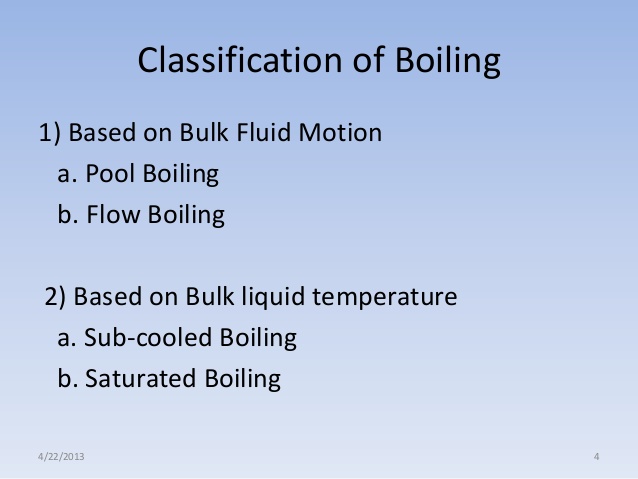Introduction
Boiling is the rapid vaporization of a liquid, which occurs when a
liquid is heated to its boiling point. (boiling point of water = 100 °C)
Boiling is the rapid vaporization of a liquid, which occurs when a
liquid is heated to its boiling point. (boiling point of water = 100 °C)
Pool boiling
If heat is
added to a liquid from a submerged solid surface, the boiling process is referred
to as pool boiling. In this process the vapour produced may from bubbles, which
grow and subsequently detach themselves from the surface, rising to the free
surface due to buoyancy effects.
OR
Pool boiling
is a mode of boiling where the fluid is stationary in the beginning with
respect to the heating surface.
STAGE OF BOILING(pool boiling)
- Free convection boiling
- Nucleate boiling
- Transition boiling
- Film boiling
POOL BOILING CURVE
Curve OA represents free convention boiling
When we light the burner, the heat transfer takes
place between the vessel and water due to free or natural convention. Thus the
values of heat flux and delta t(excess) starts increasing and when the
temperature of water reaches its saturation temperature. When delta t(excess)
attains + value, the boiling takes place. This state of boiling is known as
free convention boiling.
Curve AB represents liquid entrainment
Due to continuous heating, the value of the delta
t(excess) increases and the bubbles are formed at the bottom of the surface of
the vessel. These bubbles move upward but the collapse after covering some
distance in the water. Rising bubbles carry some water along with them. This is
known as liquid entrainment.
Curve BC represents nuclear boiling
Delta t(excess) further increases, bubbles starts
forming at a faster rate. These bubbles move upward where they break up and
release their vapour content. Due to this the heat flux attains its maximum
value known as critical heat flux.
Thus stage of boiling from A to C is known as
nuclear boiling.
Curve CD represents transition boiling
When the value of delta t(excess) increases
beyond the critical point, the heat flux start decreasing. This is because a
large fraction of the heated surface of the vessel is covered with a vapour
film. The vapour film is act as insulator.
Curve DE represents film boiling
After the transition phase, the delta T excess
further increases due to which the vessel surface is completely covered by
continuous stable vapour film. Because of high temperature, the radiation heat
transfer takes place between the heated surface and the water through the
vapour film, thus this stage is known as film boiling.



Comments
Post a Comment